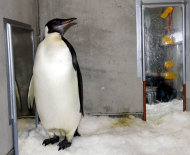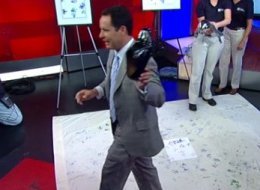Penguin parents take off for feed
Monday, 29 August 2011 Genelle Weule
ABC

One expert says the study has important ramifications for how we manage the breeding areas of penguins (Source: Phillip Island Nature Parks)
Little penguins have developed a strategy to help them survive parenthood: take regular breaks away from the kids.
That's the finding of a study of Australian little penguins, commonly
called 'fairy penguins', which has found that long trips away from the
nest help penguin parents recover from the demands of feeding a ravenous
brood.
The joint Australian and French study led by PhD candidate Claire Saraux from the
University of Strasbourg
challenges previously held beliefs that inshore birds, which forage
short distances from land, only take long trips away from the nest when
conditions are bad.
The research found that after the first couple of weeks of chick-raising, little penguins (
Eudyptula minor) alternate between two consecutive long trips, followed by several short daily trips.
This strategy is well known in offshore seabirds but virtually
unknown in inshore birds the researchers report in their study, which is
in press in the journal
Ecology.
The alternating long-short trip pattern is repeated regardless of
food availability, says Dr Andre Chiaradia study co-author and penguin
biologist with
Phillip Island Nature Parks, where the penguin colony is based.
"We found that even in a good or a bad season … they have this long
trip strategy. They [take multiple short trips to] feed the chicks …
then they go for a long trip to get feed for themselves," Chiaradia
says.
Penguin tagging
The findings were based on continuous monitoring of 200 little penguins from the Phillip Island colony over eight years.
During egg incubation and the first two to three weeks of a chick's
life, parent penguins take turns guarding the nest until the other
parent returns.
After a couple of weeks, in the 'post guard period' both birds head
out to sea to hunt and neither may return for up to 14 days, during
which time the chicks starve.
To understand what happens during this breeding phase, the
researchers monitored the microchipped penguins as they passed over
weigh-in platforms embedded into their natural pathways on the way to
and from their feeding trips.
While short trips yielded more food for the chicks, the long trips
enabled the parents to regain weight so that they could continue the
gruelling short trip feeding cycle.
The researchers believe this pattern is triggered by a loss in body mass.
"During short trips [penguin parents] are not feeding for themselves,
if they are they're little because they have this amazing thing where
they can change the pH of their stomach to slow down digestion,"
explains Chiaradia.
"So then they bring this food in and give to the chicks, but over
time they start to lose body condition because they're not eating
properly so at some stage they say 'okay, that's enough, I have to look
after myself before I actually die'."
"So then they go for long trips … and feed for themselves. When they
come back … they bring food for the chicks but much, much less than
they would do in a day trip because they are actually digesting that
food for themselves."
Chiaradia says the strategy balances the demands of raising chicks and parental survival.
"When you raise your offspring, you put in a lot of effort, but you
need to take some time to look after yourself before you burn out."
Reducing threats
Dr Belinda Cannell from the
Centre for Fish and Fisheries Research at Murdoch University studies little penguins in Western Australia.
Cannell, who was not involved in the current study, has previously tracked penguins in the incubation and guard phases.
She says the Phillip Island study has important ramifications for how we manage the breeding areas of penguins.
"I certainly knew that they could travel long distances during
incubation, but these long and short term foraging trips during the
post-guard phase mean that they could be potentially accessing areas
that they are accessing during incubation as well," says Cannell.
"It means that we've got to manage potentially larger areas than what
we thought were critical for the birds while they are raising their
chicks … so there's a much greater need for reducing threats whether
it's threats to their food abundance or threats from water craft injury
or any other coastal development threats."
Cannell says she would like to see comparative studies between
different colonies that have different resources and environmental
conditions to see if the long-short trip pattern is replicated.
"It would be interesting to see whether those longer foraging trips are further afield or if they're just more days close by."
source
##############################################################################
EXCAVATION work under Manly Wharf stopped this afternoon
following concerns the digging could disturb the area’s endangered
little penguin colony.
Manly Council staff and contractors had removed sand and begun
stormwater works near the structure but the work was called off after
volunteer penguin protectors advised council they had seen nests beneath
the wharf.
The council’s deputy general manager, Stephen Clements, said staff
were educated in identifying penguin nests and had not found any in the
area.
“All of them have been trained and they know to stop work anyway,” he said.
“But we had concerns raised today and I thought it would be better if we stopped the work until we have a really good look.”
The Manly little penguin colony is the only breeding colony of the
birds in mainland NSW and the Office of Environment and Heritage has
listed it as in danger of becoming extinct.
It cites disturbance at nesting sites, attacks by dogs and foxes, and
loss of habitat as the main reasons for the declining population, which
stands at about 60 breeding pairs.
Mr Clements said council started the work after receiving an order
from NSW Maritime, which owns the wharf, and to address problems of
flooding in nearby Gilbert and Eustace streets during heavy rain.
source






 Getty
Images - WELLINGTON, NEW ZEALAND - AUGUST 29: The emperor penguin
named "Happy Feet" stands in his container next to Gareth Morgan, who
helped fund the penguin's electronic tracking equipment, aboard …more
Getty
Images - WELLINGTON, NEW ZEALAND - AUGUST 29: The emperor penguin
named "Happy Feet" stands in his container next to Gareth Morgan, who
helped fund the penguin's electronic tracking equipment, aboard …more  View GalleryIn this Aug. 28, 2011 photo released by China's Xinhua News Agency, emperor penguin …
View GalleryIn this Aug. 28, 2011 photo released by China's Xinhua News Agency, emperor penguin …





 'Happy Feet', the penguin found wandering on a New Zealand beach in June, is heading home (Picture: PA)
'Happy Feet', the penguin found wandering on a New Zealand beach in June, is heading home (Picture: PA)


















 Penguins: not a feature of CSL's laboratory.
Penguins: not a feature of CSL's laboratory.
 "Happy Feet" on Peka Peka Beach, New Zealand, on June 21, 2011. (AP Photo/N.Z. Herald, Mark Mitchell)
"Happy Feet" on Peka Peka Beach, New Zealand, on June 21, 2011. (AP Photo/N.Z. Herald, Mark Mitchell)





















